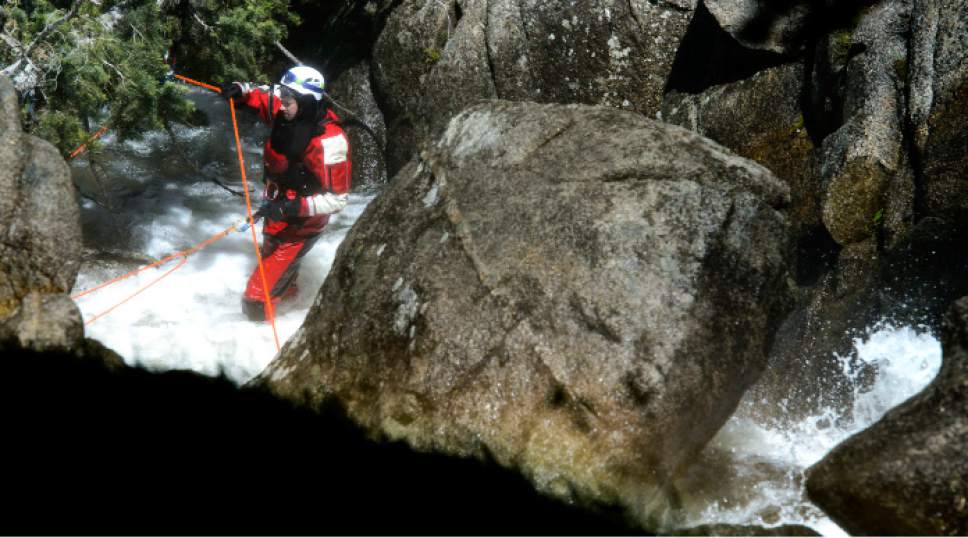This is an archived article that was published on sltrib.com in 2017, and information in the article may be outdated. It is provided only for personal research purposes and may not be reprinted.
Two Utah children who nearly drowned last month were saved by adults with CPR training — unexpected heroes who are among the 30 percent of Americans who know the lifesaving technique.
One child who narrowly escaped death was found facedown in a backyard pool at a Highland home, where a parent performed CPR until paramedics arrived. The other child, who was in a stroller that rolled into a Box Elder County canal, was saved by a man who happened to pass by. Utah County is testing a new way to alert people who have this live saving skill when someone is in need, and this comes during a year when water related tragedies have been common.
Nine other people have drowned in Utah since the year began: one in Salt Lake City's Tanner Park, one in the Ogden River, one in Blacksmith Fork Canyon, one in Spanish Oaks Reservoir, one in Flaming Gorge Reservoir, one in Bells Canyon and three in Provo River.
Though CPR may not save the life of every drowning victim, it can double or triple a person's chance of survival, the American Heart Association (AHA) says, especially if it's performed in the first few minutes of cardiac arrest. Though, 70 percent of Americans either have no training in CPR or have forgotten how to do it.
Early administration of CPR also helps lower the risk of brain function-related injuries in survivors, said Lehi firefighter and paramedic Bronson Smith. Nonfatal drowning injuries can cause severe brain damage that may result in long-term disabilities such as memory problems, learning disabilities, and permanent loss of basic functioning, according to Centers for Disease Control and Prevention.
Smith is trying to broaden the approach to educating community members about lifesaving measures like CPR, as well as giving those with training the chance to help save lives.
In the past month, Utah County has implemented an app, PulsePoint, which sends a notification to users within 500 meters of a location where CPR is needed in response to cardiac arrest, Smith said. It also will show them whether an automated external defibrillator (AED) is available.
PulsePoint is a nonprofit based in the San Francisco Bay Area with the mission of enabling community members to use lifesaving skills.
The app automatically picks up on codes that various dispatch centers send to emergency personnel, according to Smith, and will stop sending alerts to the public once the first responders arrive at the scene.
From May 10 to May 31, Smith said, 900 people in Utah County downloaded the PulsePoint app. There is no way to report an emergency through the app, Smith said, and people should call 911 in case of an emergency.
Users don't have to be CPR certified — which often requires paying about $100 for a six-hour course and passing a test — but should have some training, Smith said. Once members of a medical team arrives, they will take over.
Average response times for medical personnel typically range from four to eight minutes nationally, Smith said, but users who are notified should be able to get to the scene in about 30 seconds.
So far, the only time the app has been activated, medical professionals were already working at the scene, Smith said. But he expects it will be used more in the future.
Real-time data on PulsePoint's website show the app has been activated in more than 21,800 cases of cardiac arrest in the U.S. and Canada with more than 61,500 users who have responded.
Mountain Point Medical Center funded the project for Utah County, Smith said, including a one-time startup fee of $10,000 for implementation and the yearly fee of $13,000.
Other counties in the state have expressed interest, Smith said, but still are figuring out how to pay for it.
CPR certifications are available in Utah through various health organizations, including the American Red Cross and local hospitals.
Meanwhile, a nationwide organization, CPR Party, is introducing an unorthodox alternative that bypasses hangups like the time commitment or full cost of getting officially certified but can still prepare participants for crisis situations, founders say.
CPR Party helps individuals host hourlong parties, similar in format to Tupperware parties, where all in attendance can learn CPR from a certified instructor.
Laura Metro, CPR Party founder, got the idea after her 8-year-old son nearly drowned and was saved by a bystander.
"I considered myself to be a safety-conscious mom even before that happened," said Metro, but added that when trouble occurred, she didn't have a way to help her son.
Though Metro encourages CPR certification, "it's much better to know something than nothing at all," she said.
The parties cost $300 to host, money which goes toward paying the instructor and maintaining equipment, but scholarships are available for people who can't afford the fee, Metro said.
Certified instructors are available in Utah, she said, but no parties have been held yet here, to her knowledge.
Twitter: @mnoblenews



